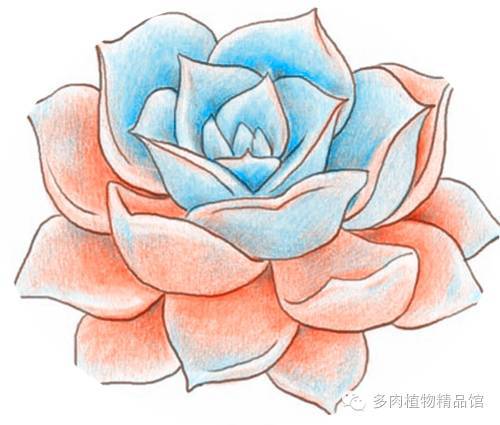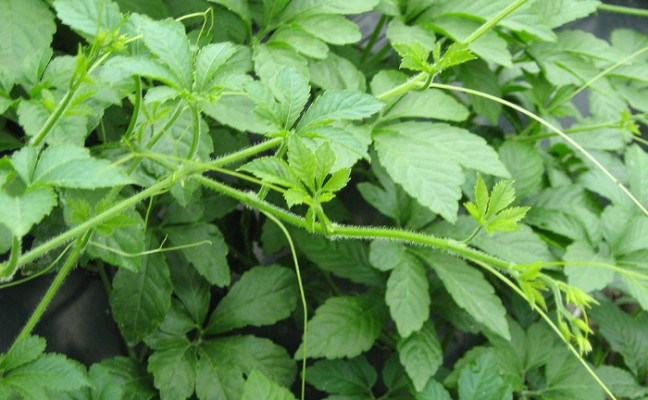That's how you play meat in autumn.

Text
Picture and text: curator
Autumn is coming, care about the autumn conservation of succulent plants, for the south. It's not autumn yet, and it's probably time for the south to start high when the temperature stabilizes below 22 ℃. Don't be too presumptuous before that, Yushan.
Phenological autumn means that after the heat, the average temperature is stable below 22 ℃ for five consecutive days, which is the cooler season of the year. In China's traditional 24 solar terms, "the Beginning of Autumn" is around August 7, while "the Beginning of Winter" around November 7 represents the end of autumn and the beginning of winter. However, due to the vast territory of our country, due to different regions, there are great differences in climate, so the real sense of autumn is also long and short, and the time of entering autumn and the end of autumn are also different in different places.
In the early autumn of August, the "autumn tiger" is still in power, especially in the south, so the climate in most parts of China is still "muggy and humid". This climate is very disadvantageous to the growth of succulent plants, and its management can still be carried out according to summer, mainly by ventilation and cooling. At the end of August and the beginning of September, with the decrease of temperature and the increase of temperature difference between day and night, the climate becomes cool and pleasant, which is a good season for succulent plants to grow and the time for succulent plants to become beautiful. After Frosts Descent, around October 22, the northern region began to get colder and frost occurred, and it will snow in some parts of the north in early November. In short, the sky is crisp in autumn, the sun is sufficient, and the temperature difference between day and night is large, which is very conducive to the growth of succulent plants, but at the same time, autumn is the season of greater climate change, sometimes continuous autumn rain, and sometimes "autumn tigers" ravage. In late autumn, there will be frost, cold current and other damage to succulent plants, but also should pay attention to prevent, so as not to cause losses.
Different types of succulent plants behave differently in autumn. Summer-type succulent plants are still in the peak growing season from August to September in autumn, and some varieties can bloom delicate flowers, but their growth slows down in October and finally stops completely. Such as: the Thor God of the tequila family, the princess thunder god, the benevolent crown, the tequila, the tiger tail orchid, the cactus family white sandalwood, the black feather jade, the mountain shadow boxing, the Euphorbiaceae golden coral, the white clothes Kuiwei jade, the spiral unicorn, the Luwei unicorn and so on.
Intermediate type-in the cooler northern region, it began to grow in late August, but the growth rate was relatively slow, while it was still dormant in the hot southern region, and generally entered the peak growing season after mid-September. Such as: crassulaceae Tianjinzhang, emerald stone, Zhu Lianshi, black mage, bear boy, Compositae blue pine, Loach palm, green bell, most of the 12-volume genera of Liliaceae.
Winter-type species, which are completely dormant in August, begin to grow slowly in September and flourish from October to early November. Such as: Amygdalaceae stone flower, meat cone flower, Ling Yaoyu, Tiannu, Liliaceae Dacangjiao Hall, Sleeping Niu, crassulaceae Jade Chun, Green Pagoda, Lu Qianxu and so on. Most varieties of Amygdalaceae succulent plants, such as stone flower and succulent cone, are in this season.
In terms of management, the succulent plants of "summer type" should be given sufficient sunlight, and most varieties can be maintained in an outdoor place with sufficient sunshine, so that they can grow healthily, so as to maintain the beauty of plant type, beautiful skin and good appearance. But in early autumn, it is best to keep the seedlings in bright light and no direct sunlight, so as to avoid excessive light, make the seedlings red and slow down or stagnate. From August to September, watering should be mastered "dry and wet". Stagnant water in the soil and excessive drought are not conducive to the normal growth of plants. if there is continuous autumn rain, we should stop watering and pay attention to drainage and waterlogging; fertilize according to different varieties. Northern areas should control watering and stop fertilization after October to enrich the stems and leaves of the plant and lay a good foundation for overwintering in the future. Due to the relatively warm climate in the south, the time of water control can be postponed to late October.
In the relatively cool northern region, the "intermediate" succulent plant began to grow in late August, while in the south, it began to grow until the first and middle of September, but the initial growth rate was relatively slow, and it could be watered properly, but not much. Do not fertilize, so as not to cause rotten roots due to excessive fertilizer and water. After the plant completely resumes its growth, normal water and fertilizer management can be carried out, and thin liquid fertilizer can be applied every 15 to 20 days according to different varieties. For the succulent plants of the 12-volume genus of Liliaceae, which require higher air humidity, the succulent plants of the genus Sandfish can be sprayed to the plant in the morning and evening, or a transparent colorless beverage bottle can be cut off from the upper part of the plant, so as to increase the air humidity and make the leaves fat and full, beautiful in color. In terms of light, it can be placed in a bright light without direct sunlight from August to September, and sufficient light can be given from October to November to absorb as much sunlight as possible, enrich the plant, and be beneficial to the beauty of the plant type.
The succulent plants of "winter type" generally begin to grow in the first and middle of September, and sufficient light can be given to varieties with extremely succulent leaves, such as Prunus, Cone, and so on, in order to make the plants grow healthily. Other varieties of "winter type" succulent plants should be protected from the hot sun. In the early stage of growth, due to the slow growth rate, the requirement for water and fertilizer is not so high, so we can pour a little water and wait for the plant to grow again in late September before normal water and fertilizer management.
The watering of succulent plants in autumn can be carried out according to the principle of "more watering of growing varieties, less watering of dormant varieties, more watering of healthy plants with exuberant growth, and less watering of weak plants". In short, it not only meets the water needs of plant growth, but also to avoid stagnant water in the soil, so as not to cause rotten roots and even the whole plant to rot in serious cases. From August to September, there will be hail and torrential rain in many parts of our country, typhoons, severe storms and other bad weather in the south, and frost and cold snap in the north in late autumn, all of which will cause great harm to succulent plants. in serious cases, it will even be "wiped out", destroying the plants that have been cultivated for many years. Therefore, we should be extra careful, always pay attention to meteorological information, do a good job of prevention, in order to prevent the harm of bad weather to plants.
In late autumn and early November, except for some varieties that are afraid of freezing moving indoors and outdoors, other varieties should be maintained outdoors as far as possible if the temperature is not too low, so as to withstand the exercise of cold climate and enhance their cold tolerance when overwintering. The so-called "spring cover and autumn freeze" is also suitable for plants. If the temperature drops below 5 ℃, consider moving all succulent plants indoors. In case of cold spell or other bad weather, no matter in the south or north, no matter what type of succulent plants should be moved indoors to prevent damage. Insecticidal drugs can be sprayed before entering the house, and indoor cultivation places should also be sterilized and killed to kill overwintering pests and harmful fungi and prevent them from spreading in the greenhouse.
From September to October, winter-type species and intermediate succulent plants can be turned over and changed soil, seedlings can be divided into pots, their roots can be trimmed, rotten and hollow old roots can be removed, and excessively long roots can be cut short to promote strong new roots; newly planted plants should not be irrigated too much water, but the air humidity should be appropriate, and water can often be sprayed to the plants to facilitate the recovery of roots and the growth of new roots. Some succulent plants of "winter type" and "intermediate type" such as stone flower, succulent flower, Ling Yaoyu and Nanmanyu can also be sown, cut and propagated in September in autumn. Some varieties of succulent plants of Cactus and Euphorbiaceae can also be grafted and propagated from mid-August to late September. Varieties that bloom in autumn should be artificially pollinated to obtain seeds and reproduce. Since most succulent plants blossom in sunny and sunny days, pollination should be well timed and some varieties should be selected for hybridization. Only in this way can the seeds with good quality and high emergence rate be produced.
The article is organized by the succulent plant boutique, the copyright belongs to the original author, some articles can not find out the source, marked as the source network, if there is any infringement, please contact us immediately, we will deal with it in time.
- Prev

Drink a cup of it every day after dinner to satisfy you not only can lose weight but also can reduce blood pressure. Do you want to consider it?
Losing weight has always been what many of us insist on, not only to become beautiful, beautiful, but also many people lose weight for good health. Our living conditions have become better now. Many people are not paying attention to their diet.
- Next

After watching these succulent summers, no matter how much they die, they will never get out of the pit.
This girl is a little sweet and succulent in summer. it really breaks the heart of her flesh friends, dead and injured, and the rest are ugly. But after looking at the following autumn meat, you will find that all the waiting in summer is.
Related
- Wuhan Hospital Iron Tree Blooming Result Was Instantly Frightened by the Gardener Master
- Which variety of camellia is the most fragrant and best? Which one do you like best?
- What is the small blue coat, the breeding methods and matters needing attention of the succulent plant
- Dormancy time and maintenance management of succulent plants during dormancy
- Minas succulent how to raise, Minas succulent plant pictures
- What are the varieties of winter succulent plants
- How to raise succulent plants in twelve rolls? let's take a look at some experience of breeding twelve rolls.
- Attention should be paid to water control for succulent plants during dormant period (winter and summer)
- Watering experience of twelve rolls of succulent plants
- Techniques for fertilizing succulent plants. An article will let you know how to fertilize succulent plants.

